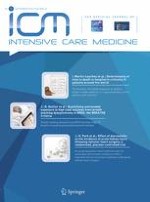Published in:

01-09-2016 | Seven-Day Profile Publication
Comparison of alcoholic chlorhexidine and povidone–iodine cutaneous antiseptics for the prevention of central venous catheter-related infection: a cohort and quasi-experimental multicenter study
Authors:
Justine Pages, Pascal Hazera, Bruno Mégarbane, Damien du Cheyron, Marie Thuong, Jean-Jacques Dutheil, Xavier Valette, François Fournel, Leonard A. Mermel, Jean-Paul Mira, Cédric Daubin, Jean-Jacques Parienti, 3SITES Study Group
Published in:
Intensive Care Medicine
|
Issue 9/2016
Login to get access
Abstract
Purpose
Compare the effectiveness of different cutaneous antiseptics in reducing risk of catheter-related infection in intensive care unit (ICU) patients.
Methods
We compared the risk of central venous catheter-related infection according to four-step (scrub, rinse, dry, and disinfect) alcoholic 5 % povidone–iodine (PVI-a, n = 1521), one-step (disinfect) alcoholic 2 % chlorhexidine (2 % CHX-a, n = 1116), four-step alcoholic <1 % chlorhexidine (<1 % CHX-a, n = 357), and four-step aqueous 10 % povidone–iodine (PVI, n = 368) antiseptics used for cutaneous disinfection and catheter care during the 3SITES multicenter randomized controlled trial. Within this cohort, we performed a quasi-experimental study (i.e., before–after) involving the four ICUs which switched from PVI-a to 2 % CHX-a. We used propensity score matching (PSM, n = 776) and inverse probability weighting treatment (IPWT, n = 1592). The end point was the incidence of catheter-related infection (CRI) defined as catheter-related bloodstream infection (CRBSI) or a positive catheter tip culture plus clinical sepsis on catheter removal.
Results
In the cohort analysis and compared with PVI-a, the incidence of CRI was lower with 2 % CHX-a [adjusted hazard ratio (aHR), 0.51; 95 % confidence interval (CI) (0.28–0.96), p = 0.037] and similar with <1 % CHX-a [aHR, 0.73; (0.36–1.48), p = 0.37] and PVI [aHR, 1.50; 95 % CI (0.85–2.64), p = 0.16] after controlling for potential confounders. In the quasi-experimental study and compared with PVI-a, the incidence of catheter-related infection was again lower with 2 % CHX-a after PSM [HR, 0.35; 95 % CI (0.15, 0.84), p = 0.02] and in the IPWT analysis [HR, 0.31; 95 % CI (0.14, 0.70), p = 0.005]. The incidence of CRBSI or adverse event was not significantly different between antiseptics in all analyses.
Conclusions
In comparison with PVI-a, the use of 2 % CHX-a for cutaneous disinfection of the central venous catheter insertion site and maintenance catheter care was associated with a reduced risk of catheter infection, while the benefit of <1 % CHX-a was uncertain.
Clinical trials identifier: NCT01479153.





